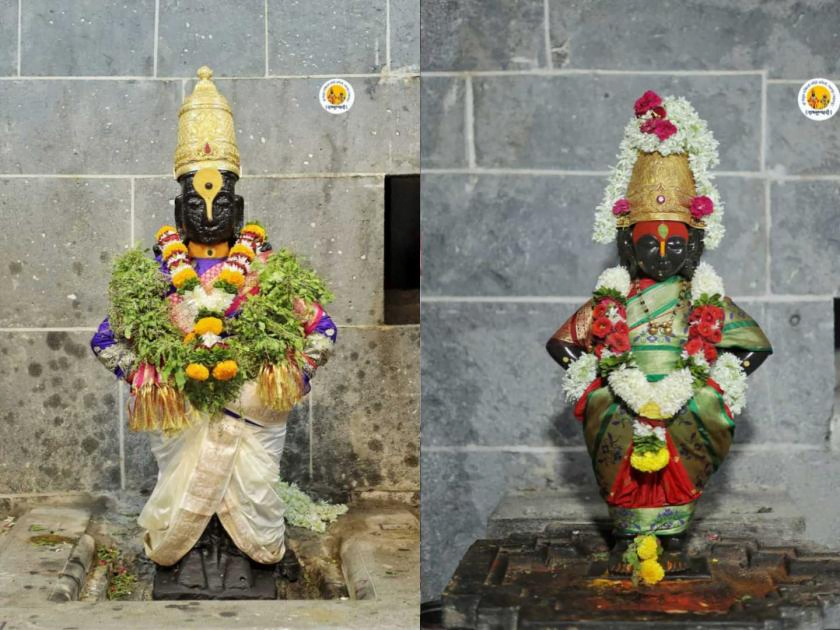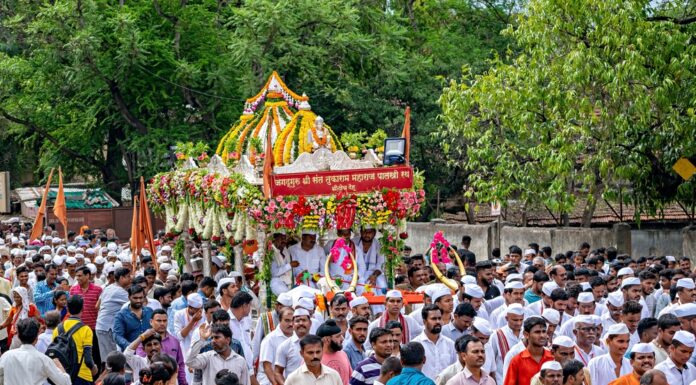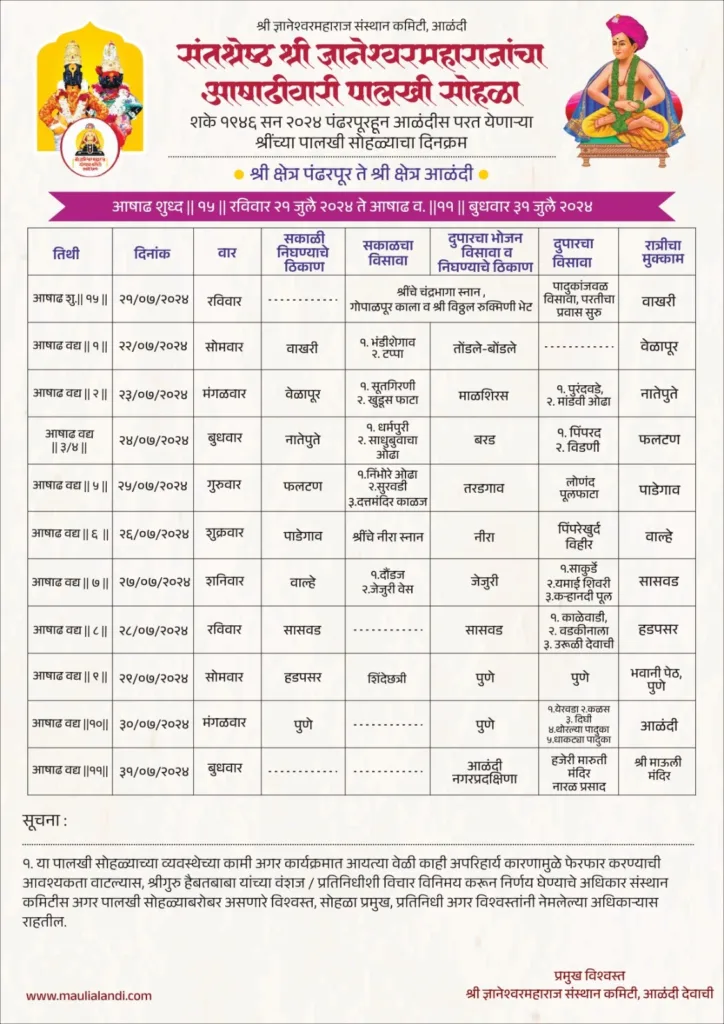Ashadhi Ekadashi Information in English 2025: Date and Timings for Ashadhi Ekadashi 2025 · Ekadashi Tithi Begins: July 6, 2025, at 10:23 PM · Ekadashi Tithi Ends: July 7, 2025, at 12:39 PM.
Ashadhi Ekadashi Information in English: Ashadhi Ekadashi Story, Pandharpur Wari, Lord Vitthal, the significance of Ashadhi Devshayani Ekadshi and much more.

Introduction:
This blog post titled “Ashadhi Ekadashi information in English: A Fabulous Guide to the Sacred Festival” provides a detailed information about Ashadhi Ekadashi highlighting how this festival is deeply respected and holds great spiritual importance in India in general and Maharashtra in particular.
Ashadhi Ekadashi, also known as Shayani Ekadashi, is a significant Hindu festival observed on the 11th lunar day (Ekadashi) of the bright fortnight of the Hindu month of Ashadha (June-July). This day is dedicated to Lord Vishnu, particularly his manifestation as Lord Vitthal or Vithoba, and holds great religious and cultural importance in India.
Ashadhi Ekadashi Essay in English | Essay on Ashadhi Ekadashi
Ashadhi Ekadashi Information in English: Significance, History, and Rituals
Ashadhi Ekadashi, a sacred and spiritually uplifting festival, holds a cherished place in the hearts of devotees. As the eleventh lunar day of the bright fortnight in the Hindu month of Ashadha, it marks the beginning of a divine slumber for Lord Vishnu. This article explores Ashadhi Ekadashi’s significance, history, and the beautiful rituals associated with it, providing comprehensive information about Ashadhi Ekadashi in English.
What is Ashadhi Ekadashi?
In this blogpost “Ashadhi Ekadashi Information in English …..” let’s know what ashadhi ekadashi is. Ashadhi Ekadashi is one of the most revered Ekadashi fasts in the Hindu calendar. The term “Ekadashi” refers to the 11th day of the lunar fortnight, and “Ashadhi” pertains to the month of Ashadha. Hence, Ashadhi Ekadashi is the 11th day of Ashadha’s bright phase.
Ashadhi Ekadashi, also known as Devshayani Ekadashi, signifies a time of deep spiritual connection. Observed during the Shukla Paksha of Ashadha, this festival heralds the start of Chaturmas, a four-month period when Lord Vishnu is believed to rest. Devotees celebrate this day with fasting, prayers, and a profound sense of devotion. Ashadhi Ekadashi information in English… helps people who don’t understand Marathi or Hindi, appreciate cultural and spiritual depth of this festival.
When is Ashadhi Ekadashi 2025? (Ashadhi Ekadashi Kab Hai)
In 2025, Ashadhi Ekadashi will be celebrated on July 6. Date and Timings for Ashadhi Ekadashi 2025 · Ekadashi Tithi Begins: July 6, 2025, at 10:23 PM · Ekadashi Tithi Ends: July 7, 2025, at 12:39 PM. This auspicious date is eagerly anticipated by those who prepare to immerse themselves in the festival’s spiritual practices and rituals. Knowing Ashadhi Ekadashi information in English ensures that the people who understand English are also well-prepared for this sacred occasion.
Historical Significance of Ashadhi Ekadashi
The origins of Ashadhi Ekadashi are deeply rooted in Hindu mythology and scriptures. It is believed that on this day, Lord Vishnu goes into a deep sleep on the cosmic serpent Shesha in the Kshira Sagar (cosmic ocean of milk), and this period of slumber, known as Chaturmas, lasts for four months until Prabodhini Ekadashi in the month of Kartik.
The Story Behind Ashadhi Ekadashi
One of the most enchanting stories associated with Ashadhi Ekadashi involves King Mandata. Facing a severe drought, the king sought guidance from sage Angira, who advised him to observe a fast on Ashadhi Ekadashi. Following the sage’s counsel, the kingdom was blessed with rain and prosperity, underscoring the festival’s spiritual power and significance. This Ashadhi Ekadashi story is an essential part of understanding this article-“Ashadhi Ekadashi information in English…”
Rituals of Ashadhi Ekadashi
Fasting and Prayers
Fasting is central to Ashadhi Ekadashi observances. Devotees abstain from food and drink, dedicating the day to worship and introspection. The fast is typically broken the following day, after offering prayers to Lord Vishnu, signifying purification and renewal. Comprehensive Ashadhi Ekadashi information in English includes these vital rituals.
Chanting and Singing Bhajans
Chanting hymns and singing bhajans dedicated to Lord Vishnu create an atmosphere of devotion and joy. These melodious offerings resonate with the divine, enhancing the spiritual ambiance and deepening the connection with the deity. These rituals are integral to Ashadhi Ekadashi information in English.
Importance of Ashadhi Ekadashi
Spiritual Benefits
Observing Ashadhi Ekadashi is believed to cleanse the soul, providing spiritual benefits that uplift and inspire. The day offers a chance for devotees to seek forgiveness and blessings, fostering inner peace and spiritual growth. Detailed Ashadhi Ekadashi information in English highlights these spiritual benefits.
Emotional and Mental Peace
The rituals and prayers performed on this sacred day bring emotional solace and mental tranquility. Devotees find a sense of calm and contentment, reconnecting with their inner selves and the divine. This aspect of Ashadhi Ekadashi information in English emphasizes its profound impact on well-being.
How is Ashadhi Ekadashi Celebrated?
Rituals and Practices
Devotees observe a strict fast on Ashadhi Ekadashi, abstaining from grains, beans, and certain vegetables. They engage in devotional activities, including singing bhajans (devotional songs), reading scriptures, and performing Vishnu Puja (worship of Lord Vishnu).
Upon reaching Pandharpur, devotees take a holy dip in the Chandrabhaga River and offer prayers at the Vithoba temple. These rituals are a culmination of their spiritual journey, providing a deep sense of fulfillment and connection with the divine. These practices are key to Ashadhi Ekadashi.
Regional Variations
While Ashadhi Ekadashi is celebrated across India, it holds a special place in Maharashtra, Karnataka, and Andhra Pradesh, where the traditions and rituals can vary. The most notable celebration is in Pandharpur, Maharashtra.
Pandharpur Ashadhi Ekadashi Wari Yatra

Pandharpur, located on the banks of the Bhima River in Maharashtra, is the epicenter of Ashadhi Ekadashi celebrations. The Wari Yatra is an annual pilgrimage that sees millions of Varkaris (devotees) walking for days to reach the Vitthal temple in Pandharpur.
The Pandharpur Yatra is more than a physical pilgrimage; it’s a spiritual odyssey. Pilgrims walk together, singing and chanting, creating a vibrant and devotional atmosphere that reflects their unwavering faith and commitment. This journey is an integral part of Ashadhi Ekadashi.
The Journey of Varkaris
The pilgrimage, known as Dindi, begins from various locations, including the towns of Alandi and Dehu. Devotees, carrying Palkhis (palanquins) with the images of saints like Sant Tukaram and Sant Dnyaneshwar, travel through numerous villages, singing abhangas (devotional songs) and spreading the message of love and devotion.
Alandi and Dehu Wari
Dehu: Dehu is the birthplace of Sant Tukaram, another iconic Marathi saint. The Wari from Dehu is equally significant, with pilgrims celebrating Tukaram’s abhangas and his deep devotion to Lord Vitthal.
Alandi: The town of Alandi is famous for being the resting place or Samadhi of Sant Dnyaneshwar, a revered Marathi saint and poet. The Wari from Alandi is marked by a vibrant and spiritual atmosphere as thousands of devotees join the procession, reflecting on Dnyaneshwar’s teachings.

Lord Vithoba and Ashadhi Ekadashi

Ashadhi Ekadashi information in English
Who is Lord Vitthal or Vithoba?
Lord Vitthal or Vithoba, an incarnation of Lord Vishnu, is the central deity worshipped during Ashadhi Ekadashi. Revered as the god of the poor and protector of devotees, Lord Vithoba holds a special place in the hearts of the faithful. Understanding his role is crucial to this post “Ashadhi Ekadashi information in English…”
His Connection to Ashadhi Ekadashi
The connection between Lord Vithoba and Ashadhi Ekadashi is profound. Devotees believe that on this day, Lord Vithoba blesses them with prosperity and happiness, making the celebrations deeply meaningful. This divine connection enriches ‘Ashadhi Ekadashi information in English…’
Customs and Traditions
Traditional Foods
Special foods prepared to break the fast on Ashadhi Ekadashi are simple and sattvic, reflecting purity and nourishment. These dishes are enjoyed in a spirit of gratitude and celebration. Traditional foods are an important part of Ashadhi Ekadashi.
Songs and Dances
Traditional songs and dances are integral to the celebrations. Devotional music and rhythmic movements create an atmosphere of joy and reverence, bringing communities together in celebration of the divine. These cultural expressions enrich Ashadhi Ekadashi information in English.
Ashadhi Ekadashi in Modern Times
Contemporary Observance
In modern times, while the essence of Ashadhi Ekadashi remains intact, the ways of observing the festival have evolved. Many devotees who cannot undertake the physical pilgrimage participate virtually or through local celebrations in their communities.
Community and Social Impact
Ashadhi Ekadashi fosters a sense of community and social unity. The Wari Yatra is a testament to the collective spirit, where people from different walks of life come together, transcending social and economic barriers.
Incorporating Technology
Technology plays a role in modern-day celebrations, with virtual gatherings and online prayers enabling wider participation. Social media platforms allow devotees to share blessings and experiences, fostering a sense of global community.
Benefits of Observing Ashadhi Ekadashi
Spiritual Benefits
Fasting and praying on Ashadhi Ekadashi are believed to cleanse the mind and soul, helping devotees focus on spiritual growth and attain divine blessings. It is a time for self-reflection, devotion, and reconnecting with one’s faith.
Health Benefits
Fasting has several health benefits, including detoxification of the body, improved digestion, and mental clarity. The discipline and mindfulness required during the fast can lead to better physical and mental well-being.
Individual Experiences
For many, Ashadhi Ekadashi is a time for personal reflection and spiritual connection. Sharing individual stories and experiences adds a unique, heartfelt dimension to the festival, highlighting its impact on personal lives.
Festival’s Impact
The practices and community bonding during Ashadhi Ekadashi leave a lasting impact, instilling a sense of peace, gratitude, and devotion that extends beyond the festival. The festival’s impact enriches Ashadhi Ekadashi.
What is Special About Ashadhi Ekadashi?
Ashadhi Ekadashi, also known as Devshayani Ekadashi, holds great significance in the Hindu religion. It falls on the 11th day of the bright half (Shukla Paksha) of the Ashadha month, typically in June or July. This day is dedicated to Lord Vishnu, one of the principal deities in Hinduism.
On this day, devotees observe a fast and offer prayers to Lord Vishnu. The belief is that by observing this fast with devotion, one can attain spiritual benefits and have their desires fulfilled. It is also believed that on this day, Lord Vishnu goes into a deep sleep (yoga nidra) on the cosmic ocean of milk (Ksheer Sagar) and awakens four months later on Prabodhini Ekadashi. This period is known as Chaturmas, a time considered inauspicious for weddings and other religious ceremonies but ideal for spiritual practices.
Why Do We Celebrate Ashadhi Ekadashi? (Essay in English)
This article ‘Ashadhi Ekadashi Information in English …’ includes an essay on Ashadhi Ekadashi.
Ashadhi Ekadashi, celebrated primarily in Maharashtra, India, holds immense cultural and religious significance. This day marks the beginning of Chaturmas, a four-month period during which Lord Vishnu is believed to be in a state of deep meditation. Devotees celebrate this day with great enthusiasm and devotion.
One of the major attractions of Ashadhi Ekadashi is the grand pilgrimage to the town of Pandharpur in Maharashtra, where the famous Vithoba Temple is located. Devotees, known as ‘Warkaris,’ undertake a long and arduous journey, chanting bhajans (devotional songs) and carrying the sacred ‘palkhi’ (palanquin) of Saint Tukaram and Saint Dnyaneshwar. This pilgrimage, known as the Pandharpur Wari, symbolizes unity, devotion, and the relentless human spirit.
On Ashadhi Ekadashi, devotees fast and spend the day in prayer, singing hymns, and listening to stories about Lord Vishnu. The fast is not merely abstaining from food but also from negative thoughts and actions, symbolizing purification of the mind and soul. By observing this fast, devotees seek blessings, forgiveness for past sins, and spiritual growth.
Ashadhi Ekadashi teaches the values of devotion, discipline, and the importance of a pure heart and mind. It is a day to reflect on one’s spiritual journey and to renew one’s faith in the divine.
What are the other Names of Ashadhi Ekadashi?
Ashadhi Ekadashi is also known by several other names, including:
- Devshayani Ekadashi
- Maha-Ekadashi
- Padma Ekadashi
- Toli Ekadashi
These names reflect different aspects and regional variations of the same auspicious day.
Why Fasting on Ashadhi Ekadashi is Important?
Fasting on Ashadhi Ekadashi holds great spiritual significance for devotees. Here are some reasons why it is considered important:
- Spiritual Purification: Fasting is seen as a way to purify the mind and body. It helps in getting rid of negative thoughts and fostering positive energy.
- Devotional Practice: Fasting is an act of devotion and dedication to Lord Vishnu. It is believed that observing this fast with sincerity can bring blessings, prosperity, and the fulfillment of wishes.
- Karmic Cleansing: It is believed that fasting on this day can help in cleansing past sins and reducing karmic burdens.
- Health Benefits: Fasting gives the digestive system a break and can have various health benefits, including improved metabolism and detoxification.
Why Do Marathi People Celebrate Ashadhi Ekadashi?
In Maharashtra, Ashadhi Ekadashi is celebrated with great devotion and enthusiasm. Here are some reasons why it holds special importance for Marathi people:
- Pandharpur Wari: One of the most significant aspects of Ashadhi Ekadashi in Maharashtra is the Pandharpur Wari. This is a grand pilgrimage to the Vithoba Temple in Pandharpur. Devotees, known as ‘Warkaris,’ walk for several days, singing devotional songs and carrying the ‘palkhi’ (palanquin) of saints like Tukaram and Dnyaneshwar. This pilgrimage symbolizes unity, devotion, and the spirit of dedication.
- Cultural Tradition: Ashadhi Ekadashi has deep cultural roots in Maharashtra. It is a time for families to come together, participate in communal prayers, and celebrate their rich heritage.
- Devotion to Vithoba: Lord Vithoba, a form of Lord Vishnu, is especially revered in Maharashtra. Ashadhi Ekadashi is a day dedicated to expressing love and devotion to Vithoba, seeking his blessings for a prosperous and harmonious life.
- Spiritual Reflection: For Marathi people, Ashadhi Ekadashi is a time for spiritual reflection and renewal of faith. It is an opportunity to focus on personal growth, both spiritually and morally.
Overall, Ashadhi Ekadashi is a day of deep spiritual significance, cultural celebration, and community bonding for Marathi people.
Ashadhi Ekadashi information in English
Conclusion
Ashadhi Ekadashi is a celebration of faith, devotion, and spiritual awakening. By embracing its rich traditions and profound spiritual practices, we can find deeper connections with the divine and each other. As we honor this beautiful festival, may its blessings and teachings continue to inspire and uplift us. This comprehensive Ashadhi Ekadashi information in English… aims to provide a complete understanding of this sacred occasion.
Ashadhi Ekadashi information in English
FAQs
What is Ashadhi Ekadashi?
Ashadhi Ekadashi is the eleventh lunar day of the bright fortnight in the Hindu month of Ashadha, marking the onset of Lord Vishnu’s divine slumber. Detailed Ashadhi Ekadashi information in English reveals its significance.
When is Ashadhi Ekadashi in 2024?
Ashadhi Ekadashi will be celebrated on July 06, 2025. Knowing the date is part of Ashadhi Ekadashi information in English.
Why is Ashadhi Ekadashi significant?
The festival holds spiritual significance as a time for fasting, prayers, and seeking divine blessings, believed to cleanse the soul and foster spiritual growth. This aspect is highlighted in Ashadhi Ekadashi information in English.
What is the Pandharpur Yatra?
The Pandharpur Yatra is a pilgrimage to the Vithoba temple in Pandharpur, undertaken by thousands of devotees during Ashadhi Ekadashi. This pilgrimage is central to Ashadhi Ekadashi information in English.
Who is Lord Vithoba?
Lord Vithoba is an incarnation of Lord Vishnu, revered as the god of the poor and the protector of devotees, central to Ashadhi Ekadashi celebrations. Understanding Lord Vithoba is crucial to Ashadhi Ekadashi information in English.
Popular Articles:
- Traditional Mehndi Designs: A Fusion of Beauty and Culture – पारंपरिक मेहंदी डिज़ाइन: सुंदरता और संस्कृति का संगम
- Vat Savitri Mehndi Designs 2024 (वट सावित्री मेहंदी डिज़ाइंस)
- Vat Savitri Puja 2024: सम्पूर्ण मार्गदर्शन
- Vat Savitri Mehndi Design: वट सावित्री के बेहद खूबसूरत मेहंदी डिजाइन
- Vat Purnima 2024 Date: जानिए वट पूर्णिमा तिथि
- Vat Savitri Vrat Katha / Vat Purnima Katha (वट सावित्री कथा सुने)
- Vat Savitri Katha PDF and MP3
- Easy Mehndi Designs for Eid Front Hand
- Vat Purnima Puja Thali ऐसे Decorate करें
- Mehndi Designs For Eid: Chand Mehndi Designs to Shine on Eid
- Guru Purnima 2024: Date, Meaning, Stories, Importance, History, Shlok, Vrat Katha, Puja Vidhi
- 6 Motivational Stories of Famous Guru-Shishya for Guru Purnima 2024
- 7 Guru Shishya Stories in English PDF
- 45+ Guru Purnima Wishes in Marathi, Guru Purnima Quotes, Message, Shubhechha, Greetings in Marathi
- गुरु पूर्णिमा निबंध Guru Purnima Essay 2024 in Amazing Style
- Bridal Mehndi Design New Trends 2024: Stunning Patterns to Elevate Your Big Day Look!
- Guru Purnima Speech in Marathi-4 Amazing Speeches
- Guru Purnima Speech in English for Standard 1 to 12 PDF Download-4 Superb Speeches
Ashadhi Ekadashi information in English Ashadhi Ekadashi Information in English : an Essay for students and teacher
Ashadhi Ekadashi Information in English


